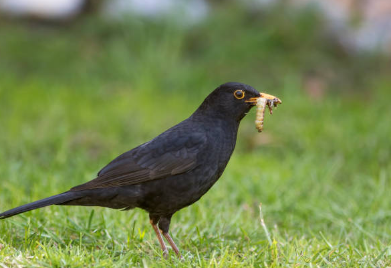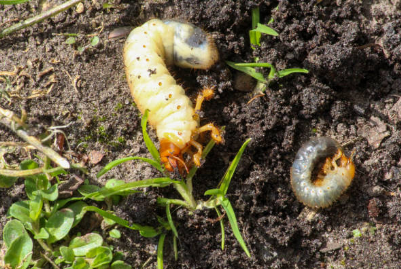
Grubs are always C-shaped, white, and have a brown head capsule. Grubs don’t have abdominal prolegs as caterpillars do. Additionally frequently brown is the raster, or tip of the abdomen. Continue reading, you will learn more about garden grubs, and identify and manage them quickly.
Table of Contents
Quick Identify the Garden Grubs
White grubs may belong to a number of different species of scarab beetles, such as Japanese beetles, European chafer beetles, masked chafer beetles, green June beetles, May/June beetles, Asiatic garden beetles, and Oriental beetles. They all roughly look the same:
- Brown heads and dirty white or off-white skin.
- Soft-bodied, “plump” appearance.
- Make a c-shape while lying on your side when at rest or exposed.
- The top half of the body with well-developed legs.
- Depending on the life cycle stage, will range in length from an inch to three inches.
- Depending on where you live, some species of larvae are more prevalent than others. You can find out which of these is most prevalent in your area from your local extension office, and they can also help you figure out what kind of grub you have.
- When it comes to controlling, knowing your grub is essential. Before you start a control measure, be sure to identify the type of grub you have because some products may only control a specific type of grub.
Garden Grubs Identification
The common name “white grub” describes the larval stage of several beetle species, and they look very similar. About an inch long when fully grown, the larvae.
Small differences can be seen with a hand lens during the closer examination. The anal slit, which serves as the feces’ exit, and the raster, the pattern of hairs on the last segment of the larvae, vary depending on the species.
The C-shaped larvae are typically grayish white with a brownish head capsule, and three pairs of legs, one on each of the first three segments behind the head, and a brownish head capsule.
Older grubs frequently have a dark posterior where the body’s contents are visible.
It is much simpler to differentiate between the adults of the common species.
What Are White Grubs?
The white grubs you find in your lawn and garden are Scarabaeidae larvae, which span several genera. They are occasionally referred to as “grub worms,” despite not actually being worms at all.
These root-feeding larvae are major pests of lawns and turfgrass, but they will also feed on the roots of edible garden plants such as potatoes and carrots, ornamentals, and weeds.
The plant’s ability to absorb nutrients and water is hampered by their feeding, which is why the first noticeable symptoms, such as wilting, chlorosis (yellowing), and stunted growth, frequently resemble drought stress and nutrient deficiencies.
Patches of discolored grass that are soft underfoot are visible in lawns where the damage has occurred.

Although these insects can kill small plants, they frequently do not harm large plants with robust, well-established root systems.
The adults feed on the foliage, and depending on the species, they can seriously harm other plants and ornamentals. That is, however, a subject for a different article.
What is Grub Injury in Garden?
Genuine white grubs consume the tiny root hairs of grasses and perhaps field crops. A crop’s capacity to absorb water and other nutrients can be reduced by dense populations that prune the roots of corn or soybean plants. Plant wilting and purpling of the leaves and stems are the symptoms of this damage that are visible above ground. Fields with heavy white grub infestations will lose stand. True white grub damage, when it occurs, is worse in early-planted cornfields because of the early plant development.
What is the Life Cycle of Garden Grubs?
True white grubs are the immature stage of May or June beetles (Phyllophaga spp.) and are an occasional pest of corn and soybean True white grubs, which are unique from other white grubs in Iowa, have a three-year life cycle. In the first summer, the adult females begin to lay eggs. The grubs hatch, consume existing roots and go through one molt before spending the winter underground. True white grub feeding doesn’t result in any visible harm during the first year. The grubs will, however, move toward the soil surface the following spring (year 2) and feed on pre-existing plant roots, which may include corn or soybean. In year two, minor grub injuries might be seen. Grubs will descend further into the soil profile in the fall to spend the winter there. Grubs will make their final trip to the soil surface and feed on roots in the spring of the third year. The grubs reach their maximum size in the third year, and the feeding is visible aboveground as plant symptoms. The following summer, in the middle of the grub’s pupal stage, it will become an adult.
How to Management Garden Grubs?
True white grubs cannot be treated with a rescue procedure, unfortunately. If scouting reveals the presence of true white grubs in a field, preventative measures should be taken before planting.
Monitoring
Monitoring is an important part of integrated pest management, as noticing a pest before it causes irreversible damage and before control options become limited is key.
As you stroll across your lawn, pay attention to how the ground feels under your feet. Dig a little to see if there are any larvae eating the roots away if it feels spongy and loose or shows signs of wilting, chlorosis, or stunting above ground.
Remove a small area of turf with a shovel, then dig through the top three inches of soil and roots to search for C-shaped larvae.
Watch out for predators as well. Along with flocks of starlings or blackbirds that land on your lawn, damage from skunks and mice can point to a problem with larval pests. Grubs are a favorite food for all of these creatures.

Do a tally as you dig. An infestation that may result in significant damage has eight to ten larvae per square foot.
Organic Control Methods
It is best to approach control with an integrated pest management (IPM) strategy. There are many methods available to control these lawn enemies.
Combining available biological and cultural practices will help you achieve this. Only use chemicals if they are absolutely necessary.
Although some species, particularly Japanese beetles, can harm foliage as adults, the roots of lawns are the ones that are most at risk from these pests. The tips below all center on maintaining control in open areas with grass.
Biological Control
The predators and parasites that nature provides, as well as those that you buy and use, are examples of biological control.
White grubs are opposed by a number of people. Ants consume the eggs, birds and some animals, such as skunks and moles, enjoy the larvae, and a few small wasps and flies parasitize the grubs.
Beneficial nematodes such as Heterorhabditis bacteriophora, available at Arbico Organics under the name Mid-August to mid-September is the time to administer NemaSeek-Hb as a curative or preventative treatment.
It is available at Arbico Organics in both granular and powder form. To further control the infestation, these products can be applied dry and watered in.
Bacillus thuringiensis subsp. galleries is a curative product that you can apply in July and September.
It effectively controls all larval instars. One and a half inches of water has entered.
Cultural and Physical Control
The best way to prevent problems is to start with plants and lawns that are as healthy as they can be. Avoid cutting the grass shorter than two inches in the summer because these beetles prefer to lay their eggs on short lawns.
If at all possible, thoroughly cultivate the area the year before seeding or laying sod, and get rid of any weeds and old plants.
Maintain your lawn by cutting back on the amount of thatch, which is the accumulation of both living and dead plant material at the roots of the plants. You should also aerate your lawn and use potassium-rich fertilizers, such as Scotts Turf Builder Fall Lawn Food, which has an NPK ratio of 32-0-10.
Organic Pesticides
Products containing neem oil, like Ecoworks EC, can be used as both a soil drench and a foliar spray.
Insects are deterred from laying eggs on your lawn and close to your plants by using Summerset AllGuard, a product made from garlic juice.

Chemical Pesticides
In cases where nothing else appears to be working to control white grubs, chemicals may be used. Depending on the product, they can be used as either curative or preventive treatments.
Organophosphates, like trichlorfon, can be used as a cure and work best when applied from mid-July to mid-October.
In August, using carbamates like carbaryl is effective as a remedy.
Neonicotinoids such as imidacloprid, clothianidin, and thiamethoxam can be used either as a preventative or a therapeutic from April to October.
When used from April to mid-September, cyaniliprole and chlorantraniliprole work well as preventative or early curative treatments.
Conclusion on Garden Grubs Identification
You can use a wide range of cultural and physical techniques, a few biological products, and some chemicals to round out your eradication strategy if necessary to control these root-chewing beetle larvae.